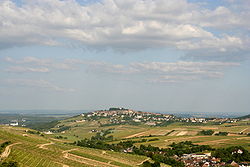
Back Sancerre (gwin) Breton Sancerre (Weinbaugebiet) German Sancerre (AOC) French Sancerre (vino) Italian サンセールAOC Japanese Vinum Sancerrense Latin Sancerre (wijn) Dutch Sancerre (vin) NB Сансер (вино) Russian Sancerre (vin) Swedish
| Wine region | |
 | |
| Type | Appellation d'origine contrôlée |
|---|---|
| Year established | 1936 (white), 1959 (red) |
| Country | |
| Part of | Loire Valley |
| Sub-regions | Ménétréol-sous-Sancerre, Chavignol, Bué |
| Size of planted vineyards | 2,600 hectares (6,425 acres) (2006) |
| Varietals produced | Sauvignon blanc, Pinot noir |
Sancerre is a French wine Appellation d'origine contrôlée (AOC) for wine produced in the area of Sancerre in the eastern part of the Loire valley, southeast of Orléans.
Sancerre is highly regarded for and primarily associated with white wine made from the Sauvignon blanc grape.[1] However both Sancerre Rouge and Sancerre rosé are made, representing approximately 20% and less than 1%, respectively, of Sancerre's total output. The basis for both the red and rosé is, as in nearby Burgundy and Champagne, the red grape Pinot noir.[2]
White Sancerre was one of the original AOCs awarded in 1936, with the same area being designated for red wines on 23 January 1959. The AOC area has expanded fourfold over the years, most recently on 18 March 1998.[3] The town lies on an outcrop of the chalk that runs from the White Cliffs of Dover down through the Champagne and Chablis. A series of small valleys cut through the chalk, each with their own soils and microclimate and terroir. In the east are the "flints" that make minerally, long-lived wines. Between the town and Verdigny the soil consists of marl and gravel – "les caillottes" – producing fruity, well balanced wines. And in the southwest, away from the river towards Menetou-Salon, the chalky "terres blanches" (white ground) produce weightier wines. Most – but not all – of the Sauvignon Blancs are unoaked.[4][5]
- ^ E. Asimov "Sancerre: Say It With Feeling" The New York Times, April 15th, 2009.
- ^ J. Ray Top 10 Loire wines" The Telegraph, January 28th, 2009.
- ^ Clancy, Tomas (2007-01-28). "A searing wine for 2007". The Sunday Business Post, Ireland. Archived from the original on 2007-09-29. Retrieved 2007-04-28.
- ^ H. Johnson & J. Robinson The World Atlas of Wine pp. 122–123, Mitchell Beazley Publishing 2005 ISBN 1-84000-332-4.
- ^ T. Stevenson "The Sotheby's Wine Encyclopedia" pp. 211–212, Dorling Kindersley 2005 ISBN 0-7566-1324-8.